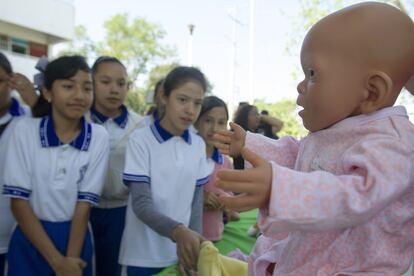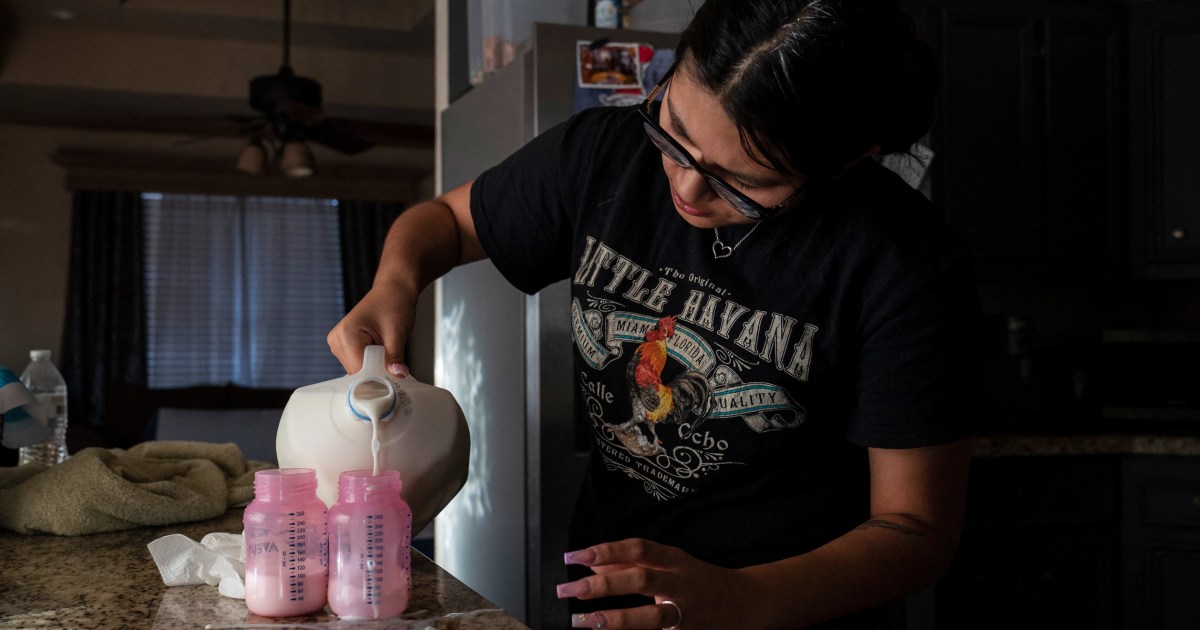A group of adolescents observe a doll during a workshop for the prevention of adolescent pregnancy in a school in Monterrey, in the state of Nuevo León. Gabriela Pérez (Cuartoscuro)
Every day 1,000 Mexican teenagers become pregnant.
They are more than 350,000 a year.
Of those, about 9,000 occur in girls under the age of 14.
Preventing early pregnancy has become one of the great demographic challenges of the country, which launched the National Strategy for the Prevention of Adolescent Pregnancy (ENAPEA) in 2015 with clear objectives for 2030: eradicate child pregnancy and reduce the rate by half. among girls between the ages of 15 and 19.
A challenge that, according to the figures and advances presented on Tuesday in a report at the Colegio de México, appears unattainable.
Mexico has stagnated as one of the countries in the world with the highest numbers of these pregnancies.
Poverty and lack of access to health services are identified as the main culprits.
Laura Flamand, a researcher at the Colegio de México and one of the authors of the report
Early Pregnancy in Mexico: Overview of Public Strategies and ENAPEA Analysis
, has asked the public to remember what they were like when they were 13 years old: what they played, what sports they liked, what three words would define what they felt then.
Would it still be the same if they had become mothers at that age?
Early pregnancy is associated with physical risks for adolescents, fewer educational opportunities, more precarious conditions of employment and salary, with greater dependency and greater exposure to gender-based violence, according to the United Nations Population Fund.
Given these consequences, the Mexican government has made it a "priority" to prevent teenage pregnancy, explained Gabriela Rodríguez, secretary of Conapo (National Population Council).
“No one should be taking care of children in their second decade of life.
Why?
Because it is a barrier for the growth of women, for social mobility”, said the official in the presentation of the document.
The Colegio de México report shows how adolescent mothers had three times fewer opportunities to have a university degree, compared to those who were able to postpone their motherhood.
Along the same lines, 75% of 20-year-old Mexican women without children work or study;
On the other hand, when young women of the same age have children in their care, only 40% study or have some paid job.
“We are also losing wealth as a country”, pointed out Flamand, who emphasizes the importance of making visible “this public problem that has very serious individual consequences, but also social and intergenerational ones”.
Mexico, the country with the highest rate of teenage pregnancies in the OECD
Mexico is the OECD country with the highest rate of teenage pregnancies, globally, it is only surpassed by the countries of Central America and sub-Saharan Africa.
The adolescent fertility rate stands at 68 per 1,000 young people between the ages of 15 and 19, according to Conapo.
Within the country, the figures also vary: Chiapas with 85 is not the same as Mexico City with 48. But in all cases, Secretary Rodríguez admits, “it is a high rate”: “We want the rate of Germany, which is three per every 1,000 adolescents.
In a regional framework, Europe has the lowest rate with 11.6 young people, followed by North America (15.8), and the situation scales up to 60.8 for Latin America and the Caribbean.
“This rate is a very clear indicator of the poverty of a country”, pointed out the Conapo secretary.
The Colegio de México report highlights how this problem does not affect all Mexicans equally.
"There is a close and complex relationship between this pregnancy and gender inequality and violence," explained Flamand.
It is 5.1 times more common among poor women, 1.6 times more likely among indigenous girls, and 1.7 times more likely in rural areas than in cities.
"The Government guarantees the exercise of sexual rights unequally between groups and between the territory," added researcher Vanesa Arvizu, who has also pointed out how access to contraceptive methods has been stagnant since 2000.
Specific fertility rate in women aged 15 to 19, according to the States in Mexico (2019). Colegio de México
There have been advances in recent decades: 50 years ago, the adolescent fertility rate in Mexico was double what it is now, but in the last 10 years the curve has practically frozen.
In other words, from 2010 to 2021, the Government's strategy has barely borne fruit.
This plan has only 88 million pesos per year —less than 4.5 million dollars— for the 32 entities that must apply it.
In a conversation with EL PAÍS, the authors of the report define ENAPEA as a well-constructed and thought-out public policy, which, however, lacks coordination between the three levels of government that must apply it, the deep turnover of personnel and bureaucratization , and, in addition, it lacks resources and materials, and greater training among those responsible.
In addition, the closure of schools, the fear of covid-19 and the increase in violence against children have been some of the barriers that the strategy has had to face in recent years.
There are still no exact figures, but government estimates calculate that during the health emergency, between 2020 and 2021, just over 29,000 additional pregnancies took place than those projected in adolescents.
The researcher and author of the report Juan Olmeda concludes: "It is practically impossible for the 2030 objectives to be met. And with the impact that the pandemic has had, even less so."
subscribe here
to the
newsletter
of EL PAÍS México and receive all the informative keys of the current affairs of this country









/cloudfront-eu-central-1.images.arcpublishing.com/prisa/6GBUDLK6XJESZBH2YV4FX6HJXQ.jpg)